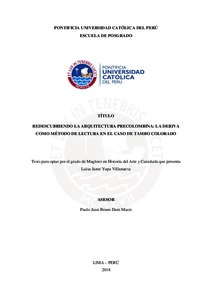| dc.contributor.advisor | Dam Mazzi, Paulo Juan Bruno | |
| dc.contributor.author | Yupa Villanueva, Luisa Janet | es_ES |
| dc.date.accessioned | 2019-02-07T16:36:40Z | es_ES |
| dc.date.available | 2019-02-07T16:36:40Z | es_ES |
| dc.date.created | 2018 | es_ES |
| dc.date.issued | 2019-02-07 | es_ES |
| dc.identifier.uri | http://hdl.handle.net/20.500.12404/13405 | |
| dc.description.abstract | La tesis tiene como propósito realizar una investigación en torno a la arquitectura
precolombina y el carácter que adquiere en la contemporaneidad. Se toma como caso de
estudio el Complejo Tambo Colorado, con la finalidad de indagar y poner a prueba otras
formas de lectura que enfaticen la experiencia con el lugar, entre la arquitectura y el
territorio.
Son las disciplinas de la arqueología y arquitectura las que entregan herramientas valiosas
para el estudio de estos sitios, debido a que parten de variables analíticas y de
documentación estudiada para la compresión histórica o formal, sin embargo ¿En qué
medida se puede generar una lectura personal de estos espacios preexistentes? ¿Es posible
darles uso o habitarlos?
En busca de responder estas interrogantes se propone una investigación hacia otra forma
de aproximación y apropiación de estos espacios preexistentes.
Esto se realiza a partir de dos rutas, ambas extraídas de prácticas artísticas del siglo XX,
la primera como base teórica a través de la aplicación del concepto de entropía propuesto
por Robert Smithson, que permite la lectura del objeto arquitectónico en otra dimensión
de valoración temporal; y la segunda por medio del método de la Deriva Situacionista,
cuyo empleo genera el descubrimiento sobre lo existente a partir de pautas e instrucciones
que buscan un recorrido dirigido por lo sensorial.
La aplicación de tales prácticas se resuelve a partir del traslado de ambos métodos o
procedimientos del campo artístico al arquitectónico, lo que resulta en otra manera de
lectura del sitio.
Se habita a través de un componente experimental que sirve como mediación entre la
arquitectura, lugar y el visitante, logrando generar un método replicable que pueda
ponerse en práctica en otros vestigios precolombinos, incluso más allá de Tambo
Colorado. | es_ES |
| dc.description.abstract | The purpose of this thesis is to research pre-Columbian architecture and the character it
acquires in contemporary times. To achieve this, the Tambo Colorado archeological
complex is used as a case study in order to test and investigate different forms of reading
the architecture that emphasize experience and sense of place between architecture and
its territory.
Archeology and architecture are the two disciplines that provide valuable tools for the
study of archeological sites. They both use analytical variables and study documentation
to reach a formal and/or historical compression. However, to what extent can you generate
a personal reading of these pre-existing spaces? Is it possible to use or inhabit them?
In an attempt to answer these questions, the thesis proposes to complementary forms of
approximation and appropriation of these preexisting spaces that may exist outside the
realm of traditional architectural and archeological research.
These complementary forms come from two artistic practices of the twentieth century,
the first, the application of the concept of entropy proposed by Robert Smithson, the
second the Situationist Derivation method. Entropy allows for the reading of the
architectural object in another dimension of temporal assessment while the Derivation
generates new discoveries on existing things from guidelines and instructions that look
for a path directed by the senses.
To apply these two practices or methods in the architectural field, they are directly
transferred from the artistic field. This results in another way of reading the site.
These methods aim to create mediation between the architecture, the place and the visitor
that is replicated in a case-by-case basis, even beyond Tambo Colorado | es_ES |
| dc.description.uri | Tesis | es_ES |
| dc.language.iso | spa | es_ES |
| dc.publisher | Pontificia Universidad Católica del Perú | es_ES |
| dc.rights | info:eu-repo/semantics/openAccess | es_ES |
| dc.rights.uri | http://creativecommons.org/licenses/by-nc-nd/2.5/pe/ | * |
| dc.subject | Ica--Restos arqueológicos | es_ES |
| dc.subject | Tambo Colorado (Perú) -- Restos arqueológicos | es_ES |
| dc.subject | Arqueología--Perú--Ica | es_ES |
| dc.subject | Urbanismo--Perú--Ica--Historia--Época Incaica | es_ES |
| dc.subject | Arquitectura del paisaje--Perú--Época Incaica | es_ES |
| dc.subject | Arquitectura inca--Perú--Ica | es_ES |
| dc.title | Redescubriendo la arquitectura precolombina: la deriva como método de lectura en el caso de Tambo Colorado | es_ES |
| dc.type | info:eu-repo/semantics/masterThesis | es_ES |
| thesis.degree.name | Maestro en Historia del Arte y Curaduría | es_ES |
| thesis.degree.level | Maestría | es_ES |
| thesis.degree.grantor | Pontificia Universidad Católica del Perú. Escuela de Posgrado | es_ES |
| thesis.degree.discipline | Historia del Arte y Curaduría | es_ES |
| renati.discipline | 222197 | es_ES |
| renati.level | https://purl.org/pe-repo/renati/level#maestro | es_ES |
| renati.type | http://purl.org/pe-repo/renati/type#tesis | es_ES |
| dc.publisher.country | PE | es_ES |
| dc.subject.ocde | https://purl.org/pe-repo/ocde/ford#6.04.02 | es_ES |






